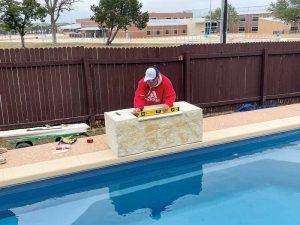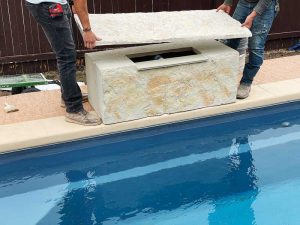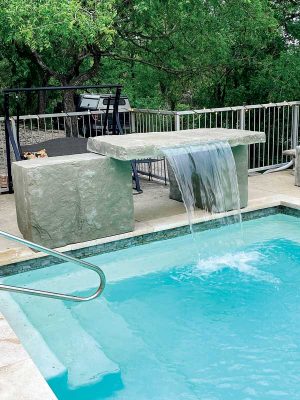
Installation process and tips
Most artificial rock water features are installed with an on-deck mount application. Concrete footings can be poured into the surrounding yard, or waterfalls can be positioned onto an existing deck space and attached with Type S mortar. This mortar is long-lasting, provides a safer bond, and is easy to mix.
When installing these water features for a new project, the waterfall area can act as another “return” to the pool. Most builders will use the same pipe size for the waterfall as they do for the rest of the pool. Generally, this is 38.1 to 50.8 mm (1.5 to 2 in.) rigid schedule 40 polyvinyl chloride (PVC) pipe. If the plumbing provided by the manufacturer is smaller, a builder can use a reducer bushing. Most manufacturers also suggest using a flexible spa hose to connect to the waterfall fitting. A ball valve or three-way valve is recommended to control the power level of the water feature, as well as the sound of the water. Often, pool owners want the waterfall to mask nearby traffic noise or prefer the sound of heavier water flow, while others want a softer sound. Using this type of valve will give them that flexibility.

If a new water feature is part of an existing pool renovation, installing a stub will help connect it to the existing plumbing, as well as the return line from the pool filter. Most manufacturers provide detailed videos on how to install a “stub up” for an existing pool. Consulting these videos along with installation manuals will also provide specific time-saving tips to ensure a flawless process.
Builders must also consider the flow rate of the water features in relation to the circulation flow rate of the existing pool. Most waterfall features have a flow range in litres per minute (lpm) (gallons per minute [gpm]). It is important to verify the waterfall is not diverting too much water away from the pool, which might compromise the circulation of the water and adversely affect the water quality. Depending on the size of the waterfall, pool professionals might need to upgrade the pump. Another key step is to check for any leaks in the plumbing system before securing the waterfall to the deck.

Once the waterfall has been fitted to the pool, the water stub up plumbing can be attached to the waterfall fitting. It is helpful to connect the pipe to the stub up with flexible PVC pipe for ease of removal and adjustments. The top of the “spillway” should also be level for proper water flow. It is best to ensure there is not too much water flowing through the waterfall, as it can sometimes splash out. This not always obvious, because it flows out behind the water feature. Not only will the pool’s water be lost, but it can also kill surrounding landscaping and vegetation.
Conclusion
Evoking the beauty of nature, today’s artificial rock water features truly appear to be quarry-found limestone. Pool builders now have access to easy-to-install, two-piece and three-piece kits to complement any modern backyard decor. These stones are perfect for sitting, lounging, or using as a launch pad to jump into the pool. They also allow builders to get creative, as their long blocks can be installed vertically or horizontally, as desired. Combined with a variety of lighting features, contrasting decking materials, and a pool’s blue interior, artificial rock water features create unity, cohesiveness, and a truly modern backyard esthetic.
Author
 Zayvian Camacho is a resident of Austin, Texas. While taking classes in landscape design, he began doing product design at RicoRock. With the company, Camacho has overseen the development of a new 2.1 m (7 ft) vertical waterfall unit, built on a structural steel frame. This type of project meshes well with his primary hobby, which is rock climbing. Focusing on design and fabrication at Rico Rock, Camacho is also part of the team developing new waterfalls and working on select construction projects. He can be reached at zayvian@ricorock.com.
Zayvian Camacho is a resident of Austin, Texas. While taking classes in landscape design, he began doing product design at RicoRock. With the company, Camacho has overseen the development of a new 2.1 m (7 ft) vertical waterfall unit, built on a structural steel frame. This type of project meshes well with his primary hobby, which is rock climbing. Focusing on design and fabrication at Rico Rock, Camacho is also part of the team developing new waterfalls and working on select construction projects. He can be reached at zayvian@ricorock.com.






